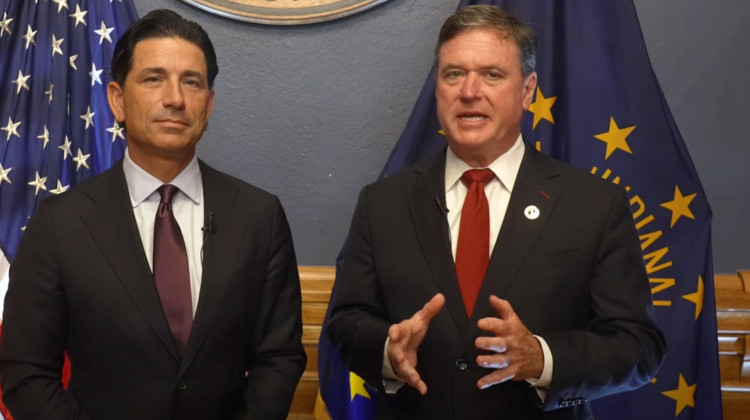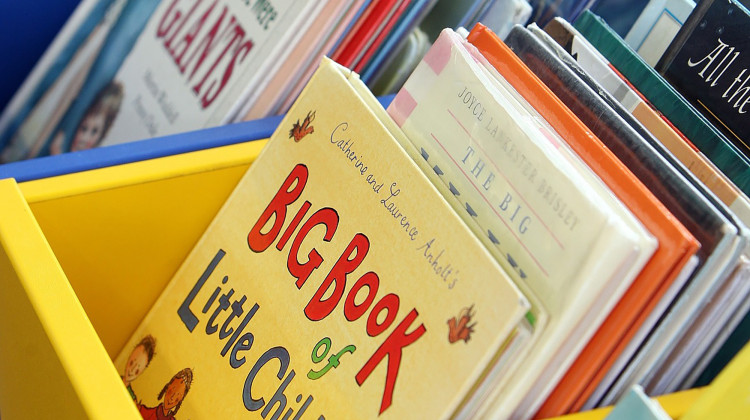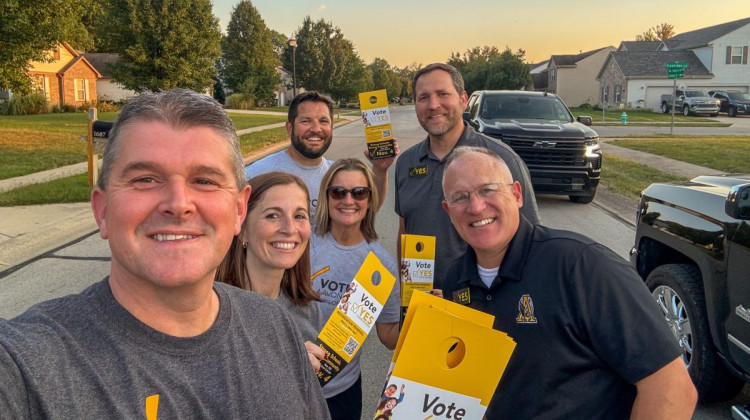
A 16-year-old boy was shot outside the Ben Davis High School football stadium during a homecoming game in October.
(Lee Gaines/WFYI)Late last month, a 15-year-old at a Michigan high school opened fire on his classmates, killing four students and injuring seven other people. The tragedy has drawn attention to a recent increase in both shootings and threats of violence at schools across the country.
In Indiana, more than a quarter of all incidents involving guns at schools statewide since 1970 occurred during the last two years, according to data from the K-12 School Shooting Database.
As of Dec. 17, there were six reports of guns being used or brandished on school property in Indiana this year, compared to four reports last year and only one in 2019.
Jillian Peterson, co-founder and president of The Violence Project — a nonprofit research center focused on violence reduction — said both shootings and threats of violence have increased nationwide during the COVID-19 pandemic.
“A lot of the shootings are fights that escalate because people have guns on them,” Peterson said. “They are occurring both in school, after school at football games, just sort of an overall record amount of gunfire at schools.”
The Violence Project recently began tracking threats of gun violence at schools dating back several years. In prior years, Peterson said there’s about 30 threats of gun violence nationwide that show up in the media per year.
“This year, in 2021, there were over 150 threats,” Peterson said. “And in just the last week alone, we've tracked another 150 threats. Schools are dealing with threats like they've never dealt with before.”
The Violence Project shared data with WFYI that shows that there were four threats of school shootings in Indiana from the start of this year through September that were written about in news media, compared to two threats in 2020 and only one in 2019.
While it’s difficult to pinpoint an exact cause of the spike in violence, Peterson said the isolation and detrimental mental health effects of the pandemic may have contributed to the problem.
“We know risk factors are things like trauma, isolation, suicidality, depression, and hopelessness, being in crisis, spending more time in the dark corners of the internet — things that we knew the pandemic kind of exacerbated,” she said. “And then on top of that, we saw record gun sales. So we know that there's just more guns that can get into the hands of kids.”
Research findings
Based on the research, Peterson said school mass shooters are typically White male students between the ages of 15 and 16.
“They tend to have trauma histories and be in a noticeable crisis,” she said. “So their behavior is changing. They are actively suicidal, and they nearly always use their parent’s guns.”
Peterson said perpetrators of school shootings also frequently leak their plans ahead of time and make threats before carrying out mass violence.
“It really is a cry for help that when someone's threatening to commit a school shooting, they are also saying that publicly for people to hear it and see it and respond to it,” Peterson said.
Recommendations for schools
Peterson recommends schools take every threat seriously, but she acknowledges the enormity of that task and the lack of resources available. Ideally, Peterson said schools should assess threats using a team approach and take preventative measures in the classroom.
“You never want one person to be making the decision how to handle this,” she said. “You want people from a mental health background, and a security and law enforcement background, and teachers and administrators to be gathering all the information you know about the student, all the circumstances surrounding it, and then really making a plan about how to intervene effectively, and then continuing to follow up.”
Preventative measures include social emotional learning, trauma screening — particularly for young boys — school-based mental health services, training teachers and staff to provide crisis intervention and suicide prevention, in addition to building crisis response teams that can asses students and connect them with the services they need.
“I think schools have to really be thinking about sort of the holistic well-being of the children in that school,” Peterson said.
Additionally, Peterson advises schools not rely solely on the criminal justice system or exclusionary discipline.
“This is just not a problem we can punish our way out of, but really approaching the situation to understand where it's coming from and what that student needs in terms of intervention,” she said.
Recommendations for elected officials
Few states have laws on the books that require guns to be stored unloaded and locked while unattended. But Peterson said passing safe storage laws could make a “huge difference” in curbing the epidemic of gun violence in schools.
Following a 2018 shooting at a Noblesville middle school, former Republican State Sen. Jim Merritt proposed a bill in the 2019 legislative session that would have required gun owners to make a “reasonable effort” to prevent children from accessing their firearms. The bill died without even receiving a hearing.
Peterson said lawmakers should also consider funding prevention efforts, like school-based mental health services, threat assessment and crisis response teams. Additionally, she said funding schools to enable smaller class sizes could give teachers more time and energy to notice when students are in crisis.
Recommendations for parents and caregivers
Peterson said more than 80 percent of mass shooters they studied were in a “noticeable state of crisis” prior to the shooting. She suggests parents and caregivers be on the lookout for changes in behavior, “whether that’s increased isolation or more abusive than normal or depressed or anxious or agitated.”
And when parents or caregivers notice these issues, Peterson said it’s important to “be willing to spend the time and space, to dig in, to ask the hard questions about suicide, to ask about what’s really going on with someone.”
She said someone in crisis is “like a balloon ready to pop.” If parents and schools respond with punitive measures like suspension or criminal charges, “it’s just intensifying the crisis and intensifying the grievance,” she said.
Peterson said it’s important to “find ways to let a little bit of air out, to give kids room to breathe, and to get them connected to services they need.”
Contact reporter Lee V. Gaines at lgaines@wfyi.org. Follow on Twitter: @LeeVGaines.
 DONATE
DONATE







 Support WFYI. We can't do it without you.
Support WFYI. We can't do it without you.